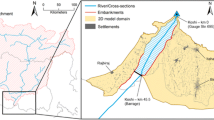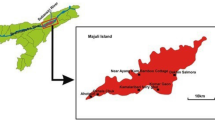Abstract
Existing riverbank riprap could face the risk of failure if the flood regime changes in future. Additionally, changed sediment transport in rivers, as a possible result of climate change, impacts the failure risk of flood protection measures. Evaluation of this potential failure is the primary issue of riprap stability and safety assessment. The consequences of the bank failure are probably uncontrolled erosion and flooding with disastrous consequences in residential areas or damage to infrastructures. Thus, a probabilistic analysis of riprap failure considering different mechanisms due to the flood and sediment transport uncertainties is required to assess embankment stability. In this article, the concept of a probabilistic assessment model based on Monte Carlo simulation method, moment analysis methods, and Rosenblueth point estimation method are presented to define the failure risk of riprap as the river bank protection. The probability of failure in different modes, namely direct block erosion, toe scouring and overtopping, has been defined by taking into account the river bed level variation based on bedload transport described with a probabilistic function of the peak discharge. The result of three models comparison revealed a good agreement (the average deviation of less than 2%) in estimation of riprap failure probability. This model is a strategical tool to search the critical river reaches and helps to evaluate the risk maps. So that, the model could cover the engineering aspect of environmental stability in the rivers with riprap as the bank protections.










Similar content being viewed by others
References
Ang AHS, Tang WH (2007) Probabilistic concepts in engineering emphasis application to civil and environmental engineering. Wiley, New York
Blodgett CE, McConaughy JC (1986) Rock riprap design for protection of stream channels near highway structures. Evaluation of riprap design procedures. vol 2. U.S. Geological Survey, Sacramento
Conciatori D, Brühwiler E, Morgenthaler S (2009) Calculation of reinforced concrete corrosion initiation probabilities using the Rosenblueth method. Int J Reliab Saf 3(4):345–362
Escarameia M, May RWP (1992) Channel protection downstream of structures. Rep. SR 313. HR Wallingford, London
Fernandes W, Naghettini M, Loschi R (2010) A Bayesian approach for estimating extreme flood probabilities with upper-bounded distribution functions. J Stoch Environ Res Risk Assess 24:1127–1143. doi:10.1007/s00477-010-0365-4
Froehlich DC (2011) Sizing loose rock riprap to protect stream bank. J River Res Appl 29(2):219–235. doi:10.1002/rra.1587
Froehlich DC, Benson CA (1996) Sizing dumped rock riprap. J Hydraul Eng ASCE 122(7):389–396
Haldar A, Mahadavan S (2000) Probability, reliability and statistical methods in engineering design. Wiley, New York
Hartford ND, Baecher GB (2004) Risk and uncertainty in dam safety. Thomas Telford, London
Heimann FUM, Rickenmann D, Böckli M, Badoux A, Turowski JM, Kirchner JW (2015) Calculation of bedload transport in Swiss mountain rivers using the model sedFlow: proof of concept. Earth Surf Dyn 3:35–54. doi:10.5194/esurf-3-35-2015
IPCC (2002) Workshop on changes in extreme weather and climate events. Beijing, China
IPCC (2007) Climate change 2007: synthesis report, Contribution of Working Groups I, II and III to the fourth assessment report of the Intergovernmental Panel on Climate Change, Geneva
Jafarnejad M (2016) In: Schleiss A (ed) Time dependent failure analysis of large block size riprap as bank protection in mountain rivers. Thesis 6803, Communication N° 62 du Laboratoire de constructions hydrauliques, Ecole Polytechnique Fédérale de Lausanne, Lausanne. doi:10.5075/epfl-lchcomm-62
Jafarnejad M, Pfister M, Schleiss AJ (2012) Failure risk analysis of riverbank ripraps with Monte Carlo simulation. In: Proceedings of the international conference on fluvial Hydraulics. Taylor & Francis Group, CRC Press, London, pp 1325–1330
Jafarnejad M, Franca MJ, Pfister M, Schleiss AJ (2014) Effect of compressed riprap thickness on the stability of river banks. In: Schleiss et al (ed) Proceedings of the international conference on fluvial hydraulics, river flow 2014. Taylor & Francis Group, CRC Press, London, pp 2069–2074
Ji ZH, Li N, Xie W, Wu JD, Zhou Y (2013) Comprehensive assessment of flood risk using the classification and regression tree method. J Stoch Environ Res Risk Assess 27:1815–1828. doi:10.1007/s00477-013-0716-z
Julien PY (2002) River mechanics. Cambridge University Press, London
Kassa NA (2009) Probabilistic safety analysis of dams- methods and applications. Dissertation, University of Dresden, Dresden
Kikkawa H, Ikeda S, Kitagawa A (1976) Flow and bed topography in curved open channels. J Hydraul Div ASCE 102(9):1372–1382
Köplin N, Schädler B, Viviroli D, Weingartner R (2012) Relating climate change signals and physiographic catchment properties to clustered hydrological response types. Hydrol Earth Syst Sci 16(7):2267–2283. doi:10.5194/hess-16-2267-2012
Lagasse P, Clopper PE, Zevenbergen LW, Ruff JF (2006) Riprap design criteria, recommended specifications, and quality control. National Cooperative Highway Research Program, Washington, DC
Li L, Xu CY (2014) The comparison of sensitivity analysis of hydrological uncertainty estimates by GLUE and Bayesian method under the impact. J Stoch Environ Res Risk Assess 28:491–504. doi:10.1007/s00477-013-0767-1
Li RM, Simons DB, Blinco PH, Samad MA (1976). Probabilistic approach to design of riprap riverbank protection. In: Rivers 76 symposium on inland waterways for navigation, flood control, and water diversions, vol 1. American Society of Civil Engineering, Fort Collins, pp 1572–1591
Maynord ST, Neill C (2008) Riprap design. In: García HM (ed) Sedimentation engineering: processes, measurements, modeling, and practice. American Society of Civil Engineering, Reston
Maynord ST, Ruff JF, Abt SR (1989) Riprap design. J Hydraul Eng ASCE 115(7):937–949
Maynord ST, Ruff JF, Abt SR (1991) Closure of discusion on riprap design. J Hydraul Eng ASCE 1977:542–544
Meyer V, Scheuer S, Haase D (2009) A multi criteria approach for flood risk mapping exemplified at the Mulde river, Germany. Nat Hazards 48:17–39. doi:10.1007/s11069-008-9244-4
Permanent International Association of Navigation Congress (PIANC) (1978) Risk consideration when determining bank protection requirements. Report of Permanent Technical Committee 1, Supplement to Bulletin 58. PIANC, Brussels
Recking A, Pitlick J (2013) Shields versus Isbash. J Hydraul Eng ASCE 139(1):51–54. doi:10.1061/(ASCE)HY.1943-7900.0000647
Schleiss AJ (1998) Bemessung und Gestaltung von Blockwürfen an Gebirgsflüssen. Interpraevent. Villach. Tagungspublikation 2:351–360
Smart, GM, Jaeggi M (1983) Sediment transport on steep slopes Mitt. Nr. 64 der Versuchsanstalt fiir Wasserbau, Hydrologie und Glaziologie, ETH, Zurich
Stevens MA, Simons DB, Lewis GL (1976) Safety factors for riprap protection. ASCE J Hydraul Div 102(HY5):637–655
Stevens MA, Simons DB, Richardson EV (1984) Riprap stability analysis. Transp Res Board Transp Res Rec 2:209–216
Tian Y, Booij JM, Xu YP (2014) Uncertainty in high and low flows due to model structure. J Stoch Environ Res Risk Assess 28:319–332. doi:10.1007/s00477-013-0751-9
Turowski JM, Yager EM, Badoux A, Rickenmann D, Molnar P (2009) The impact of exceptional events on erosion, bedload transport and channel stability in a step-pool channel. Earth Surf Process Landf 34:1661–1673. doi:10.1002/esp.1855
Van Dyck J, Willems P (2013) Probabilistic flood risk assessment over large geographical regions. Water Resour Res 49:3330–3344. doi:10.1002/wrcr.20149
Wittler RJ, Abt SR (1988) Riprap design by modified safety factor method. In: Proceeding of national conference on hydraulic engineering. American Society of Civil Engineering, Colorado Springs, pp 143–148
Wu Y, Zhong PA, Xu B, Zhu F, Ma B (2016) Changing of flood risk due to climate and development in Huaihe River basin, China. J Stoch Environ Res Risk Assess. doi:10.1007/s00477-016-1262-2
Acknowledgements
The research project is financed by the Swiss Federal Office for the Environment (FOEN) under Contract No. A2111.0239/10-0019.PJ/J372-1192.
Author information
Authors and Affiliations
Corresponding author
Rights and permissions
About this article
Cite this article
Jafarnejad, M., Pfister, M., Brühwiler, E. et al. Probabilistic failure analysis of riprap as riverbank protection under flood uncertainties. Stoch Environ Res Risk Assess 31, 1839–1851 (2017). https://doi.org/10.1007/s00477-016-1368-6
Published:
Issue Date:
DOI: https://doi.org/10.1007/s00477-016-1368-6




